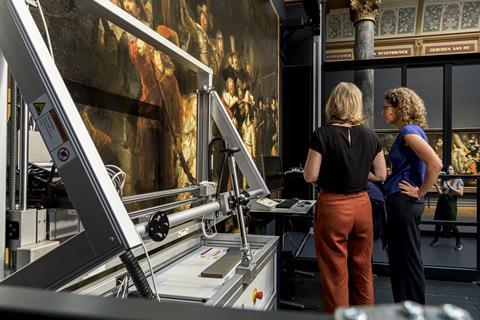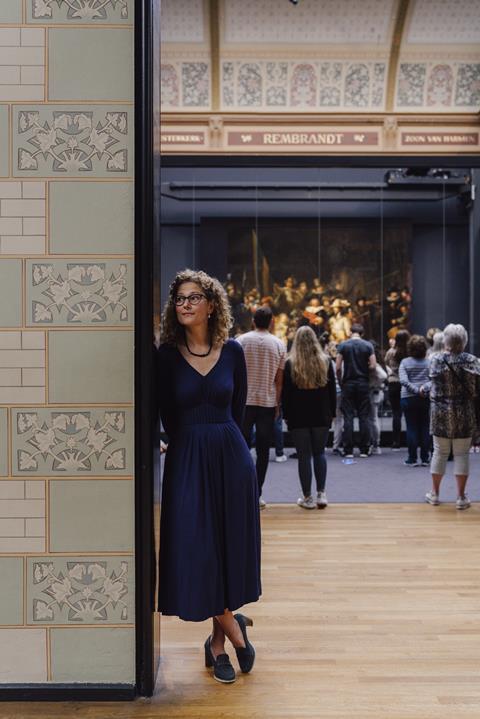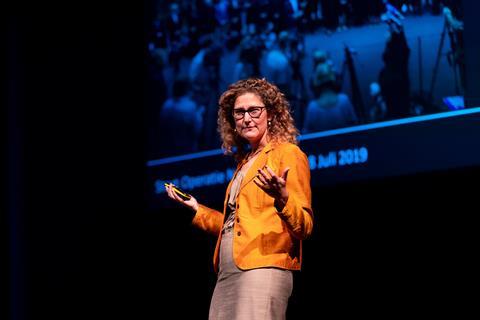Katrien Keune uses complex, heterogeneous samples to try to better understand pieces of art. She is currently responsible for the scientific research within Operation Night Watch. ‘The way we are now researching the Night Watch would not have been possible five years ago.’
At the end of the nineteenth century, researchers were already using the then newly discovered X-rays to look through oil paintings. But in the last few decades, the scientific analysis of art has expanded enormously. Using enormous amounts of data, researchers are trying to find out what chemical and physical processes take place in art objects.
In her work at the Rijksmuseum in the Netherlands, first as a researcher and since 2019 as head of the Science department, chemist Katrien Keune links fundamental research on the properties and behaviour of materials to the appearance of pieces of art in the collection. Keune tries to gain insight into how that appearance has changed in the past and may change in the future. She is currently responsible for the scientific research within Operation Night Watch, a large-scale research and conservation project in which Rembrandt’s famous painting is being meticulously mapped out using a wide range of analysis techniques.
‘You usually don’t get to study the Night Watch every month or year, so this is truly a once-in-a-lifetime opportunity’
A career in art research is not an obvious choice for a chemist. How did you get there?
‘I knew very early on that I wanted to go in this direction and that I wanted to reach it through chemistry and not through art history. When I studied chemistry at the University of Amsterdam, there was actually nothing in this field available at all, so it was certainly not a foregone conclusion that I would go in that direction. You then try to make choices that enrich you in the areas where you still need knowledge. For internships of a very fundamental nature, I looked for a counterpart within the museum field. You are always looking for components that contribute to your main objective and from which you can learn and draw new energy.’
Does museum research receive appreciation from hardcore chemistry?
‘If you lean towards the alpha sciences, it is quickly seen as a hobby, because people see it as a luxury product. It is never seen as something worthwhile, but I don’t think that is relevant at all. With our research, we show that there is so much interesting chemistry taking place that is super-complex and not easily mimicked in a fume hood. There is polymer chemistry, redox reactions, you name it. The knowledge we generate about materials is extremely valuable. Moreover, you have to apply all kinds of advanced techniques and develop methods to understand this type of objects.’

‘Art objects are unique, which means you don’t have much bulk material to measure’
What distinguishes your field in this respect?
‘Our materials are not simple homogeneous systems. Moreover, art objects are unique, which means you don’t have a lot of bulk material to measure. We have to come up with all kinds of clever tricks to still obtain information, such as model systems or reconstructions. When we do research with particle accelerators, we always have the most complex samples compared to other users, because we want information about materials that are present in very low concentrations and also heterogeneously distributed.’
How has the field developed in the time you have been active?
‘I keep saying that we are actually still in our infancy, while we have also come a long way. At this time we’re asking very different and more complex questions. Twenty years ago we just discovered the phenomenon of metal soaps. These are compounds of metal ions with fatty acids that accumulate in the paint layer and often crystallise on the surface. Surveys showed that this was a major problem in collections worldwide. But for me, metal soaps are now a thing of the past. It’s about the interaction between metals and organic compounds in the paint, how cations mobilise and then react with components in the paint or gases from the environment to create new products.’
So you’re focusing more and more on the process, on the stage before something forms?
‘You start with a degradation product that is a problem in a painting. You investigate it, but eventually you see much larger, overarching chemical principles, interactions that go beyond that degradation product alone. You can easily move the sliders in Photoshop and visualise how a painting changes, but the chemistry in that process is much more complex and that is what you want to understand. Then it is about reaction kinetics – how fast does something react, when and where does something crystallise? – and our understanding of that is actually very limited.’
You mentioned the development of analytical techniques. Is more always better in that respect?
‘Sometimes there is a bit of a problem with ‘overdata’. We can generate enormous amounts of data and this is happening faster and faster, but despite the smart algorithms, it is still important to interpret and integrate this data properly. In addition, the challenge is not only how we produce data, but also how we ensure that it remains usable for everyone.’
Talking about usable knowledge: how does the fundamental research translate to museum practice?
‘That is exactly what makes my role so interesting. I am embedded in a restoration studio at the museum and every day we have discussions and questions about this very topic. What is the point, what do we still need to know? That’s what’s so good about Operation Night Watch, that we have weekly meetings with conservators, restorers and researchers where we ask each other questions from all sides. That way you immediately see where all the holes in the science are, because there are many questions that I can’t answer at the moment.’
You’ve already mentioned Operation Night Watch, the large-scale scientific research of Rembrandt’s most famous painting. What makes this project so unique?
’Besides the close cooperation between the various groups within the museum, it’s mainly the mix of complementary techniques that we use. The way we are now researching the Night Watch would not have been possible five years ago. The speed and resolution of analytical techniques have improved so rapidly in recent years. Our ambition is to get the most complete picture possible of the painting, of the materials used and of its condition. You usually don’t get to study the Night Watch every month or year, so this is truly a once-in-a-lifetime opportunity.’
And what does all that research yield?
‘We see, for example, a great many changes in the composition of the Night Watch: feathers on hats that have been removed, positions of legs that have been adjusted, lances that have been angled. In addition, spectroscopic methods show that many parts of the painting once had more colour gradations, were more nuanced. We detected, for example, red organic pigments or the blue pigment smalt which have been decoloured. Or old varnish remnants that give a certain cloudiness. The analyses also show that Rembrandt consciously used different gradations and qualities of pigments. In this way we learn an enormous amount about his technique and use of materials.’

‘The reaction kinetics - how quickly does something react, when and where does something crystallise? - we actually still understand very little’
To what extent is the knowledge generated by Operation Night Watch representative for other art?
‘In any case it can be used for all other paintings by Rembrandt. You actually enter a little bit into the artist’s DNA. You find out about his choices and considerations, you know how the material changes, you recognise the restoration history. When you then look at another work by that artist, you begin to understand it better. And the knowledge you gain about the behaviour of materials is directly relevant to many other works of art.’
And do you now know what should be done with the Night Watch?
‘Everything is a risk assessment. We will have to make decisions about the treatment phase with the best of our knowledge, while there are still unanswered chemical questions. But our research does provide the ingredients to determine that risk on an increasingly better basis and to see what you have to do. We’re not done yet!’

Between worlds
Katrien Keune is head of the Rijksmuseum Science Department, responsible for scientific research within the museum, and associate professor at the University of Amsterdam. Keune did her PhD research at AMOLF, focusing on the interaction between pigment and binder in oil paint, did an internship at DSM and conducted research at the National Gallery in London. She was a guest lecturer at the Reinwardt Academy and worked as a freelance researcher for museums, cultural institutions and restoration studios.













Nog geen opmerkingen